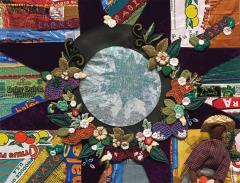UMF Emery Community Arts Center presents “VOYAGER: Migrational Narratives,” exhibit, Jan. 30–March 6
- January 15, 2020

UMF Emery Community Arts Center presents “VOYAGER: Migrational Narratives,” exhibit, Jan. 30–March 6
Interactive opening reception, Thurs., Jan. 30, features pop-up virtual reality experience and performance
FARMINGTON, ME (January 15, 2020)—The UMF Emery Community Arts Center is proud to present “VOYAGER: Migrational Narratives,” an exhibition of more than a dozen artists and authors—all of whom have experienced migration firsthand. VOYAGER will be on view from Jan. 30 to March 6, 2020.
An interactive opening reception, Thursday, Jan. 30, from 4-7 p.m., will feature a performance by visual artist Arturo Herrera. Additionally, documentary filmmaker Daniel Quintanilla and collaborators Shuab Mahat and Hilowle Aden will present their pop-up virtual reality experience, “A Shared Space: Lewiston.” Viewers will have the opportunity to put on an Oculus Rift and experience the stories of two immigrant fathers raising their families in Lewiston.
The exhibition and opening reception are free and open to the public. Faculty, student clubs, local schools and community groups may contact Ann Bartges, ann.bartges@maine.edu, about holding class sessions, workshops and other events in the exhibition space.
Interweaving performance, photography, painting, video, sculpture, textiles, poetry and prose, this group exhibition explores themes of home, distance, craving, belonging, dreaming and more. As the title implies, VOYAGER honors the narratives of people moving places.
This aim is echoed in the gallery with the ethereal audio-recording of Mohja Kahf’s poem, “Voyager Dust,” as it plays from overhead speakers. The poem beckons our senses with the scent of Syria in a mother’s scarves and the softness of a sweater stitched in China. Similar to the exhibition, these clothes contain the “dust” of departures and arrivals—the ongoing journeys of various voyagers.
Like Kahf’s poem, many of the works on exhibit convey sentiments of loss, longing, hope and possibility, alluding to complex patterns, histories and causes of migration. In Nayda A. Cuevas’s mixed-media collage, “Adios: Puerto Ricans Always in Migration,” the image of an embrace foregrounds a map connecting the island and mainland. Cuevas’s collage visualizes the cyclic longing of those who leave, remain and return only to leave again.
In Firoz Mahmud’s series “Soaked Dream,” the artist creates photographic portraits of families who work in factories. Parents and children peer out of fantastical green glasses crafted from their tools. Recently selected as a finalist for the COAL prize in France, Mahmud’s work speaks to the aspirations and uncertain futures of displaced persons in Bangladesh and South Asia, more broadly, due to natural and social disasters.
Other works on view approach immigration through everyday objects to interrogate questions of finding home and feelings of dis/belonging. Leila Hernandez’s textile series, “La Visa Negra,” pieces together fragments of black inner tubes, chip packages and other recycled materials to portray the journeys and daily lives of migrant laborers and refugees who have crossed the Rio Grande.
In her collage, “Completely out of Water,” Éireann Lorsung plays with the symbolic material significance of discarded papers found in the streets of Brussels and second-hand items from thrift stores. While Lorsung’s work considers estrangement and othering in Brussels,Parisa Ghaderi and Ebrahim Soltani’s series, “Go Home!,” stages photographs in an IKEA store to explore how a body, one’s first home, assimilates and interacts with a new space.
Several sculptural pieces reflect on tensions within and across languages, cultures, and borders. The three paraffin door knobs from TeaYoun Kim-Kassor’s “Paradox”seriespresent the image of doorknobs without doors, creating a feeling of distance and disorientation.
On the gallery floor, the clear tiles of Josephine Lee’s, “A Stone’s Throw from the Old Country,”turn the childhood game of hopscotch into a playful allegory of the ways that distance from home exposes the structures of space and language. The animal masks from Arturo Herrera’s experimental performance series, “The National Bird,”suggest the performative nature of identity in relationship to real and imaginary worlds.
Expanding the Conversation on Migration
Co-curators and UMF faculty members, Ann Bartges and Olivia Donaldson are excited to expand the conversations and narratives of migration present in the art exhibition by also including documentary works and stories from several nonprofit organizations. In the downstairs lobby, visitors will find literature, oral histories, digital stories and informational videos from The Telling Room in Portland, Maine Historical Society, Immigration History Research Center and Migration Matters. These local, national and international entities provide important historical, political, and socio-cultural contextualization for the art encountered in the gallery space. Project statements and discussion prompts proposed by the artists offer additional supports and language for interpreting and discussing their creative works.
Filter Press Releases
Contact Information
April Mulherin
246 Main StreetFarmington ME 04938
207-778-7081
ude.eniam@nirehlum.lirpa
